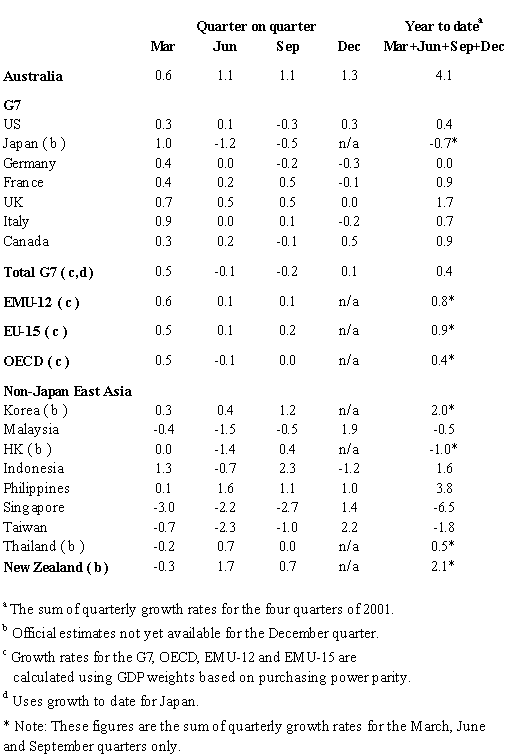In the face of the major global economic slowdown the Australian economy grew by an exceptionally strong 1.3 per cent in the December quarter and by 4.1 per cent through the year to December 2001. The National Accounts also provide further evidence that strong economic growth continues to be accompanied by low inflation and record high productivity growth.
Over the course of 2001, the Australian economy markedly outperformed the world's developed economies. Australia's economic growth rate of 4.1 per cent over 2001 compares with an OECD average of less than 0.5 per cent over the same period. Amongst the G7 economies, the strongest growth rate over 2001 was the UK at less than 2 per cent, with the remaining members below 1 per cent (see attached table).
Economic growth was underpinned by strong growth in household consumption of 1.3 per cent in the December quarter. This follows solid growth in the June and September quarters and household consumption was 4.2 per cent higher through the year to December. This is the first time since the December quarter of 1999 that through the year growth in household consumption has exceeded 4 per cent, and is a sign of strong consumer confidence supported by low interest rates.
Private new business investment grew by a strong 5.7 per cent in the December quarter, with new machinery and equipment investment rising by a very strong 11.1 per cent, more than offsetting a modest fall in new investment in non-dwelling buildings and structures of 2.8 per cent. This rebound in business investment follows a period of subdued spending and probably represents a turning point. Looking forward, there are positive signs of strengthening business investment. The Australian Bureau of Statistics' first survey of capital expenditure intentions for 2002-03 implies very strong growth in investment in both equipment and buildings, and investment intentions are particularly strong in the capital-intensive mining industry.
Economic growth in the December quarter was also supported by dwelling investment, which rose by a solid 4.1 per cent. This follows the very strong growth of around 14 per cent in the September quarter. Forward indicators for housing construction have moderated in recent months, suggesting that new housing construction activity is currently at or near a peak.
Net exports subtracted 1.5 percentage points from GDP growth in the December quarter. The significant detraction from net exports in the quarter reflected both lower exports (down 3.2 per cent) - which in part was due to a decline in inbound tourism and some rural exports - and higher imports (up 4.4 per cent). The strength of the domestic economy has led to a rise in imports across most categories, including a strong rise in capital goods reflecting higher investment expenditure.
Over the year to the December quarter net exports subtracted 0.7 of a percentage point from overall economic growth, despite bleak global economic conditions with a synchronised world downturn and a period of stalling or declining output among Australia's major trading partners. Australia's current account deficit was 3.7 per cent of GDP in the December quarter, around its 30 year average, following the 20 year low of 1.8 per cent of GDP recorded in the September quarter.
The December quarter National Accounts also confirm that inflationary pressures remain moderate. The household consumption chain price index - a broader measure of consumer prices than the CPI - increased by 0.7 per cent in the December quarter and by 2.4 per cent through the year to December 2001. The December quarter increase in the household consumption chain price index is below the 0.9 per cent increase in the CPI, which was influenced by a range of seasonal and one-off factors.
Non-farm average earnings (AENA) increased by a moderate 0.4 per cent in the December quarter and by 3.6 per cent through the year to December. Other indicators of wages growth, such as the Wage Cost Index (which increased by 3.4 per cent through the year to the December quarter) and enterprise bargaining outcomes, have also been relatively subdued in recent quarters. Productivity (measured as GDP per hour worked) grew by a very strong 1.7 per cent in the December quarter and a record 5 per cent through the year to the December quarter. Moderate wage outcomes, combined with very strong productivity growth, are consistent with inflation outcomes being comfortably within the 2 to 3 per cent target band over the period ahead.
The National Accounts measure of profits in the private non-financial corporate sector recorded strong growth in the December quarter, rising by 5.8 per cent, to be 10.8 per cent higher through the year to December.
Increases in production were recorded across most sectors of the economy in the December quarter, with the strongest increases reported in personal and other services (up 3.5 per cent), wholesale trade (up 3.3 per cent), health and community services (up 2.9 per cent), and electricity, gas and water supply (up 2.7 per cent). Communication services, and accommodation, cafes and restaurants posted declines (down 4.4 per cent and 2.3 per cent respectively).
The global economic outlook remains the greatest concern for Australia's economy, but at least there are tentative signs starting to emerge that the downturn in the world economy has bottomed and recovery may be underway. The latest growth figures indicate that the MYEFO forecast of 3 per cent GDP growth in Australia in 2001-02 as a whole is readily achievable. Despite some remaining risks for the Australian economy associated with uncertainties in the global environment, sound fundamentals are playing a vital role in insulating Australia.
ATTACHMENT
International growth comparisons

